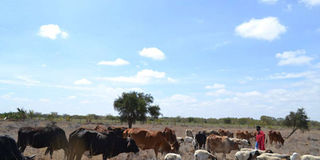Pastoralists on the edge as land usage changes

A herder grazes livestock in Kajiado. A new study has revealed that 64 percent of the entire Kajiado County is now private land that is not open for grazing. PHOTO | ISAIAH ESIPISU | NMG
What you need to know:
- A new study reveals that 64 percent of the entire Kajiado County is now private land that is not open for grazing.
- According to Dr Stephen Moiko, a scientist from the Kenya Markets Trust (KMT) working on the project, “Privatisation of land can lead to greater investment opportunities for those who can secure land, but it marginalises the poor in the process.”
- The study further reveals that between 1997 and 2015, Kajiado County’s cattle population reduced by 41.7 per cent, and apart from land privatisation, the scientists are also attributing it to the changing climatic conditions.
- In Kenya, around 80 per cent of the total land mass is semi-arid and is home to about 11 million people, out of a national population of about 47.2 million.
In Olosho Oibor vilage in western part of Kajiado County, Samson Seketion, a pastoralist has set aside 50 acres for hay harvesting as a way of adapting to tough climatic conditions amid the shrinking rangeland.
“In my youthful days, there were no boundaries in this area and as a herds boy, I could freely move my father’s cattle to any part of the land with greener pastures,” says Seketion.
However, in the recent past, the pastoralist lifestyle has changed because the formally communal land has been subdivided, and some of it has either been developed or fenced off pending development.
A new study reveals that 64 percent of the entire Kajiado County is now private land that is not open for grazing.
“The only way I can cope with the new development is by fencing off my land as well, so that I restrict other people from grazing on it to preserve the pastures for my 200 cattle,” says Seketion.
In the pre-colonial period, there was open ownership of land in Kajiado. Herders could graze their animals in any part of the county without obstacles.
Until 1970s, when pastureland was demarcated into communal ranches, and later into shareholding ranches in the 1990s, land in Kajiado supported pastoralists because they had enough space for grazing.
But not anymore, the land has been subdivided into smaller plots, most of them sold to individuals who have already and are still investing in real estate following increased demand for land due to expanding towns and population pressure.
So far, a place like Athi-Kapuetei Plains (which includes Kitengela and Athi River) and another place like Central Hills are 99.6 and 100 per cent privatised in that order – according to the study commissioned by the Canada-based International Development Research Centre (IDRC) and the UK based Department for International development (DFID).
According to Dr Stephen Moiko, a scientist from the Kenya Markets Trust (KMT) working on the project, “Privatisation of land can lead to greater investment opportunities for those who can secure land, but it marginalises the poor in the process.”
“Unlike the privatisation schemes, communal tenure regimes might spur more suitable investments and provide better tenure security for poorer groups with benefits for the whole community,” says the scientist.
MAINSTREAM CLIMATE CHANGE POLICY DEVELOPMENT
In general, poor communities in arid and semi-arid regions have been greatly impacted by land privatisation, which has led to land fragmentation, land sales and growing inequality in terms of economy and gender.
Dr Joanes Atela, one of the researchers of the study conducted under the Pathways to Resilience in Semi-arid Economies (PRISE) project, says that land tenure transition in Kajiado may force the local Maasai community to shift their livestock management and investment patterns from traditional free-range pastoral systems to intensive systems.
“There is need for tenure regimes that embrace both technical-economic and social-cultural solutions in the pastoral communities,” says Atela.
The study further reveals that between 1997 and 2015, Kajiado County’s cattle population reduced by 41.7 per cent, and apart from land privatisation, the scientists are also attributing it to the changing climatic conditions.
“We observed that temperatures in Kajiado have increased by 1.48oC in the past 50 years, and this is badly affecting survival of cattle, which is the county’s main source of livelihoods,” said Dr Mohammed Said, one of the lead researchers of the project.
Projection shows that the county’s temperatures are going to increase by 1.0oC by 2030.
The study further gives worrying statistics, where all 21 arid and semi-arid counties have experienced increase in temperatures in the last 50 years, with five counties surpassing the 1.5oC increase. They include Turkana (1.8oC), West Pokot, Elgeyo Marakwet (1.91oC), Baringo (1.8oC), Laikipia (1.59oC) and Narok (1.75oC).
The scientists are therefore calling on national and county governments to mainstream climate change in policy development, implementation and ensure that coordination of programmes are better placed to support sustainable land use, planning, drought mitigation interventions, and suitable land tenure forms in arid and semi arid lands.
In land policies and investment strategies, the study recommends that the county governments and the National Land Commission should recognise the rights of various social groups and agro-ecological conditions, and enable different land tenure regimes that support more productive, and sustainable ownership and investments.
In Kenya, around 80 per cent of the total land mass is semi-arid and is home to about 11 million people, out of a national population of about 47.2 million.
Most of the population in these arid and semi-arid lands are traditional pastoralists who respond to climate stresses by moving from one area to another.





